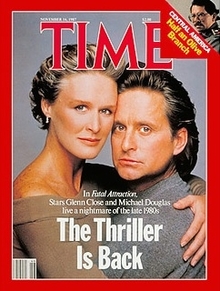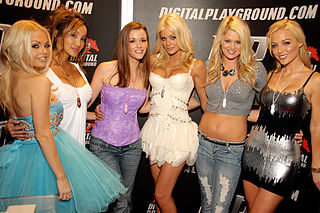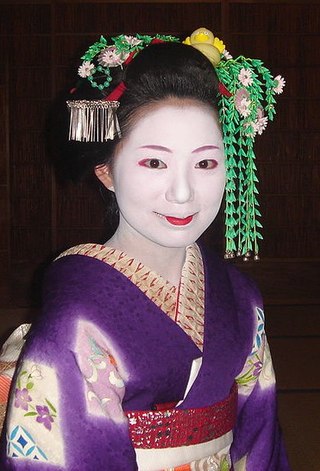Related Research Articles

Bondage pornography is the depiction of sexual bondage or other BDSM activities using photographs, stories, films or drawings. Though often described as pornography, the genre involves the presentation of bondage fetishism or BDSM scenarios and does not necessarily involve the commonly understood pornographic styles. In fact, the genre is primarily interested with the presentation of a bondage scene and less with depictions of sexuality, such as nudity or sex scenes, which may be viewed as a distraction from the aesthetics and eroticism of the sex scenario itself.

Ecchi is a slang term in the Japanese language for playfully sexual actions. As an adjective, it is used with the meaning of "sexy", "dirty" or "naughty"; as a verb, ecchi suru means "to have sex", and as a noun, it is used to describe someone of lascivious behavior. It is softer than the Japanese word ero, and does not imply perversion in the way hentai does.

Sex appeal in advertising is a common tactic employed to promote products and services. Research indicates that sexually appealing content, including imagery, is often used to shape or alter the consumer's perception of a brand, even if it is not directly related to the product or service being advertised. This approach, known as "sex sells," has become more prevalent among companies, leading to controversies surrounding the use of sexual campaigns in advertising.

Romance is a 1999 French arthouse film written and directed by Catherine Breillat. It stars Caroline Ducey, Rocco Siffredi, Sagamore Stévenin and François Berléand. The film features explicit copulation scenes, especially one showing Ducey's coitus with Siffredi. Romance is one of several arthouse films featuring explicit, unsimulated sex, along with The Brown Bunny (2003), 9 Songs (2004) and All About Anna (2005).

An exploitation film is a film that tries to succeed financially by exploiting current trends, niche genres, or lurid content. Exploitation films are generally low-quality "B movies", though some set trends, attract critical attention, become historically important, and even gain a cult following.
The Maritime Film Classification Board is a government organization responsible for reviewing films and granting film ratings in New Brunswick, Nova Scotia and Prince Edward Island.
Video games featuring sexual content have existed since the early days of the industry. They can be found on most platforms and can be of any video game genre.

Lesbian erotica deals with depictions in the visual arts of lesbianism, which is the expression of female-on-female sexuality. Lesbianism has been a theme in erotic art since at least the time of ancient Rome, and many regard depictions of lesbianism to be erotic.

A sexploitation film is a class of independently produced, low-budget feature film that is generally associated with the 1960s and early 1970s, and that serves largely as a vehicle for the exhibition of non-explicit sexual situations and gratuitous nudity. The genre is a subgenre of exploitation films. The term "sexploitation" has been used since the 1940s.
In film, nudity may be either graphic or suggestive, such as when a person appears to be naked but is covered by a sheet. Since the birth of film, depictions of any form of sexuality have been controversial, and in the case of most nude scenes, had to be justified as part of the story.

The Cinema of the Philippines began with the introduction of the first moving pictures to the country on August 31, 1897, at the Salón de Pertierra in Manila. The following year, local scenes were shot on film for the first time by a Spaniard, Antonio Ramos, using the Lumiere Cinematograph. While most early filmmakers and producers in the country were mostly wealthy enterprising foreigners and expatriates, on September 12, 1919, Dalagang Bukid , a movie based on a popular musical play, was the first movie made and shown by Filipino filmmaker José Nepomuceno. Dubbed as the "Father of Philippine Cinema," his work marked the start of cinema as an art form in the Philippines.
Philippine Comics have been popular throughout the nation from the 1920s to the present. Comics scholar John A. Lent posited that the Philippine comics tradition has "the strongest audience appeal, best-known cartooning geniuses, and most varied comics content" in Asia after Japan and Hong Kong.

The Movie and Television Review and Classification Board is a Philippine government agency under the Office of the President of the Philippines that is responsible for the classification and review of television programs, motion pictures and home videos.

The erotic thriller or sexual thriller is a film subgenre defined as a thriller with a thematic basis in illicit romance or sexual fantasy. Though exact definitions of the erotic thriller can vary, it is generally agreed "bodily danger and pleasure must remain in close proximity and equally important to the plot." Most erotic thrillers contain scenes of softcore sex and nudity, though the frequency and explicitness of those scenes can differ from film to film.
Sex comedy, erotic comedy or more broadly sexual comedy is a genre in which comedy is motivated by sexual situations and love affairs. Although "sex comedy" is primarily a description of dramatic forms such as theatre and film, literary works such as those of Ovid and Geoffrey Chaucer may be considered sex comedies.
Vaudeville in the Philippines, more commonly referred to as bodabil, was a popular genre of entertainment in the Philippines from the 1910s until the mid-1960s. For decades, it competed with film, radio and television as the dominant form of Filipino mass entertainment. It peaked in popularity during the Japanese occupation in the Philippines from 1941 to 1945. Many of the leading figures of Philippine film in the 20th century, such as Dolphy, Nora Aunor, Leopoldo Salcedo and Rogelio de la Rosa, began their showbusiness careers in bodabil.

A pornographic film actor or actress, pornographic performer, adult entertainer, or porn star is a person who performs sex acts on video that is usually characterized as a pornographic movie. Such videos tend to be made in a number of distinct pornographic subgenres and attempt to present a sexual fantasy; the actors selected for a particular role are primarily selected on their ability to create or fit that fantasy. Pornographic videos are characterized as either softcore, which does not contain depictions of sexual penetration or extreme fetishism, and hardcore, which can contain depictions of penetration or extreme fetishism, or both. The genres and sexual intensity of videos is mainly determined by demand. Depending on the genre of the film, the on-screen appearance, age, and physical features of the actors and their ability to create the sexual mood of the video is of critical importance. Most actors specialize in certain genres, such as straight, bisexual, gay, lesbian, bondage, strap-on, anal, double penetration, semen swallowing, teenage, orgy, age roleplay, fauxcest, interracial or MILFs and more.
In the Philippines, pornography is not specifically defined in Philippine law, but the Revised Penal Code of the Philippines considers certain acts to be obscene or indecent and these are prohibited as immoral doctrines, obscene publications, indecent shows, or other similar material or portrayals that advocate human immorality, obscenity, and indecency. Philippine legislation penalizes participation in these unlawful activities, and Republic Act No. 7610 extends punishment to those involved in child abuse, child exploitation, child prostitution and discrimination of children.

Sexuality in Japan developed separately from that of mainland Asia, as Japan did not adopt the Confucian view of marriage, in which chastity is highly valued. Monogamy in marriage is often thought to be less important in Japan, and sometimes married men may seek pleasure from courtesans. Prostitution in Japan has a long history, and became especially popular during the Japanese economic miracle, as evening entertainments were tax-deductible. Decreased sex drive in the 21st century has been blamed for the low Japanese birth rate and declining growth of the Japanese population.

Sex in film, the presentation of aspects of sexuality in film, specially human sexuality, has been controversial since the development of the medium. Films which display or suggest sexual behavior have been criticized by religious groups or have been banned or censored by governments, although attitudes have changed much along the years and a more permissive social environment has developed in certain parts of the world, notably in Europe, North America, Australia and New Zealand. In countries with a film rating system, films which contain explicit sex scenes typically receive a restricted classification. Nudity in film may be regarded as sexual or as non-sexual.
References
- 1 2 3 Hawkins, Michael G. (2010). "Our Men in Manila The Secret Agent Film Craze of the 1960s in the Philippine Postcolonial Imagination". Philippine Studies. 58 (3): 349–381. ISSN 0031-7837. JSTOR 42634639.
- ↑ "When 'bomba' sex films were a staple of Philippine cinemas and their female stars graced magazine covers". South China Morning Post. 17 February 2019. Archived from the original on 11 May 2019. Retrieved 18 June 2022.
- ↑ Atienza, John Adrianfer (2021). "Locating the 1960s Filipino Western Genre". Southeast Asian Media Studies Journal. 3 (3) – via ResearchGate.